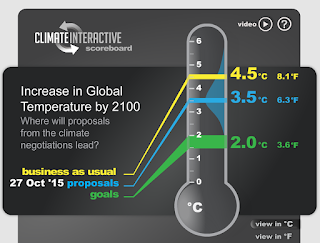 |
| Christiana Figueres thoughts on the INDCs, Source, Twitter. |
The Intended Nationally Determined Contributions (INDCs) mark a change of tack in approaches to tackling climate change, utilising a bottom a bottom up approach in addition to top down governance (click here for debate on bottom up/top down approaches), in which countries put forward their pledges in the context of their own national circumstances, capabilities and priorities to reduce climate change.
146 countries representing 86% of the world's carbon emissions filed pledges (UNFCCC, 2015) in the lead up to Paris basically saying what they were willing to do straight up, before the negotiations. The plans represent a significant advance on current trends with much to positive about. One of the most significant findings is that according to the UNFCCC the INDCs will bring average emissions per capita down by as much as 8% in 2025 and 9% by 2030. Furthermore they have the capability of limiting temperature rise to around 2.7 °C by 2100. Other positive findings in the UNFCCC synthesis report (2015) highlight how:
- The INDCs indicate a significant increase in the number of countries taking climate action
- National processes put in place to prepare the INDCs helped place climate change high on the political agenda of many governments and created a new and significant momentum for action
- Somewhat significantly, the majority of the INDCs also included an adaption component demonstrating the imperative to adapt alongside efforts to reduce greenhouse gases. Past critiques of top down approaches have cited a lack of adaption.
Yet as highlighted in a Nature special the INDCs are still some way off reaching the 2 degree target. The IEA special briefing for COP21 found that the pledges would still result in a increase of 3.7 gigatonnes of CO2 from 2014 to 2030. By 2030 the annual growth in energy related emissions worldwide will slow to just 0.5% a year. Yet they will still be substantial, and will not have come to a halt - "a critical and urgent milestone to achieving the global climate goal".
Furthermore, the think tank Climate Interactive argues that if no further action is taken after the end of the countries pledge period of 2030 will still result in expected warming in 2100 of 3.5 °C (fig. 1) (with a range of uncertainty of 2.0-4.6 °C). Furthermore, Joe Romm the author of a highly accredited blog argues that the UNFCCC press release above is in fact a little bit misleading in its use of its 2.7°C by 2100 statistic, successfully misleading the Guardian in a recent article. The majority of the INDC pledges end by 2030 so a 2.7 °C temperature change prediction is based on the rather large assumption that countries fulfill all their pledges up to 2030 and then continue to reduce emissions after 2030. The INDCs no longer seem so rosy. However, if further action is taken these figures could improve. There are large unknowns. Yet the the 3.5 °C calculation does assume that no unmodeled carbon cycle feedback kicks in such as permafrost melting (Romm 2015).
 |
| The Climate Interactive scoreboard, Source Climate Interactive. |
However, on balance I agree with Christiana Figueres, executive director of the UNFCCC when she argues that although the INDCs do not lower future temperatures enough they are significant improvement on the warming predicted by the IPCC. It would be somewhat naive to expect the INDCs to solve all the climate problems straight away. Figueres has stressed that the INDCs are just the first step. They are only relevant over the medium term and were never going to reach 2 degrees by themselves. The are "a departure point and not a destination, the Paris agreement will construct a path of ever-increasing emission reductions with periodic checkpoints of progress until we get to the 2 degree pathway" Figueres (2015). There are also hopes that a regular review mechanism will also be agreed in Paris, by which the INDCs could be ratcheted up in further steps providing a foundation for higher ambition.
As the conclusion of the synthesis report reminds us "parties have submitted their INDCs with the understanding that they would be anchored in a broader new climate agreement that would support sustainable actions nationally and globally". We can but hope that this really happens in Paris over the next two weeks.
No comments:
Post a Comment